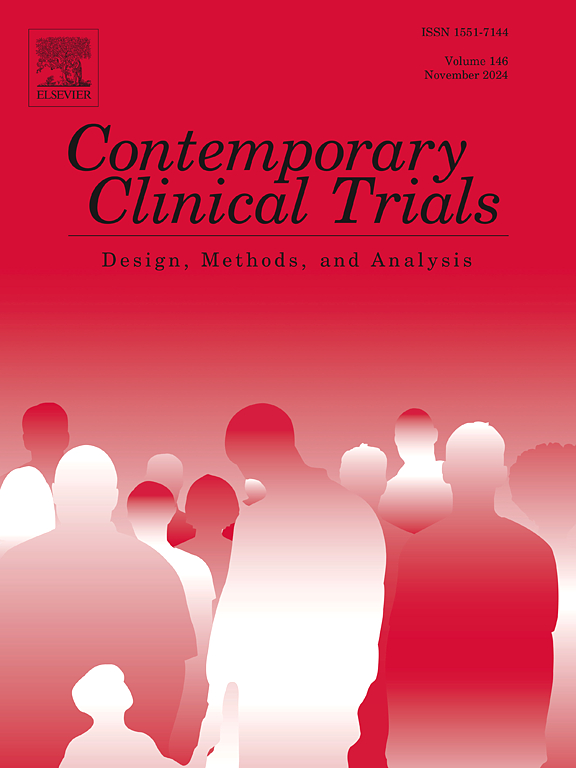远程医疗MOM研究:产后护理远程医疗多成分优化模型(MOM)的随机对照试验方案。
IF 1.9
3区 医学
Q3 MEDICINE, RESEARCH & EXPERIMENTAL
引用次数: 0
摘要
目的:对阿肯色州医院急诊科(ED)进行横断面研究,旨在:1)评估急诊科与产科急诊相关的经验和能力;2)描述有和没有产科服务的医院在妊娠和产后患者ED实践方面的差异。方法:于2023年8月向阿肯色州各医院急诊科部门经理发放在线调查邀请。这项包含40个问题的调查收集了医院特点、急诊科处理产科急诊的经验和能力、员工培训历史和兴趣。对答复进行了描述性分析,并对提供和不提供产科服务的医院之间的比例差异进行了测试。结果:84名合格的急诊医生中有51名(61 %)的管理人员做出了回应。71%的急诊科(35/49)曾紧急运送过孕妇或产后患者,43% %(20/47)在过去12 个月内分娩。没有产科服务的医院的急诊科分娩的可能性较小(27 %对56 %),有能力进行一些产科手术,如给予子宫强张药物(58 %对100 %),并要求在电子健康记录中评估产后状态(0 %对33 %)。大多数(19/35;54 %)的受访急诊科管理人员在过去两年中未向员工提供产科急诊培训。结论:虽然产科急诊在本研究中所代表的阿肯色州医院急诊科并不罕见,但许多急诊科在识别和管理这些病例的准备方面存在差距。在这个样本中改进准备工作的主要机会包括培训工作人员和要求对育龄妇女的怀孕和产后状况进行评估。底线:关于急诊部门(ED)与产科并发症相关的实践数据有限。我们对阿肯色州51家(61% %)医院急诊科的管理人员进行了横断面调查,以评估急诊科在产科急诊方面的经验和管理能力。在过去的一年中,急诊科中大约有1 / 3的急诊科发生了意外分娩,而紧急转运孕妇或产后患者的发生率为2 / 3。改善急诊科做法的关键机会包括对产后状况进行一致的评估,并提供有关产科主题的工作人员培训。本文章由计算机程序翻译,如有差异,请以英文原文为准。
The Telehealth MOM Study: Protocol for a randomized controlled trial of the Telehealth Multi-component Optimal Model (MOM) of postpartum care
Background
A substantial proportion of maternal morbidity and mortality occurs in the postpartum period. In 2018, the American College of Obstetricians and Gynecologists (ACOG) published new guidelines recommending that all women have contact with a maternity care provider by 3 weeks postpartum. Although this revised schedule addresses the evident need for enhanced postpartum care, it has not been tested in a clinical trial and implementation has been hampered by logistical and financial constraints. The goal of this study is to evaluate the effect on postpartum outcomes of the Telehealth Multi-Component Optimal Model (MOM) of postpartum care, which delivers the early postpartum visit through telehealth.
Design
We will conduct a type 1 hybrid effectiveness-implementation trial of the Telehealth MOM postpartum care model. This randomized-controlled trial will enroll 1500 diverse pregnant women at five obstetric clinics across Arkansas. We will randomize participants 1:1 to receive enhanced standard of care or the Telehealth MOM model, with remote monitoring of blood pressure and temperature for 14 days postpartum and a telehealth screening for complications between 6 and 14 days after birth. Outcomes are obtained from health records (postpartum visit completion, early detection of complications, readmissions) and surveys at 9 weeks, 6 months, and 13 months postpartum. Qualitative interviews with patients, providers, and study staff will inform development of an implementation blueprint.
Conclusion
This study will contribute much needed evidence regarding the effectiveness of telehealth and remote monitoring in the early postpartum period and can inform policies and strategies for implementing the 2018 postpartum care guidelines.
求助全文
通过发布文献求助,成功后即可免费获取论文全文。
去求助
来源期刊
CiteScore
3.70
自引率
4.50%
发文量
281
审稿时长
44 days
期刊介绍:
Contemporary Clinical Trials is an international peer reviewed journal that publishes manuscripts pertaining to all aspects of clinical trials, including, but not limited to, design, conduct, analysis, regulation and ethics. Manuscripts submitted should appeal to a readership drawn from disciplines including medicine, biostatistics, epidemiology, computer science, management science, behavioural science, pharmaceutical science, and bioethics. Full-length papers and short communications not exceeding 1,500 words, as well as systemic reviews of clinical trials and methodologies will be published. Perspectives/commentaries on current issues and the impact of clinical trials on the practice of medicine and health policy are also welcome.

 求助内容:
求助内容: 应助结果提醒方式:
应助结果提醒方式:


